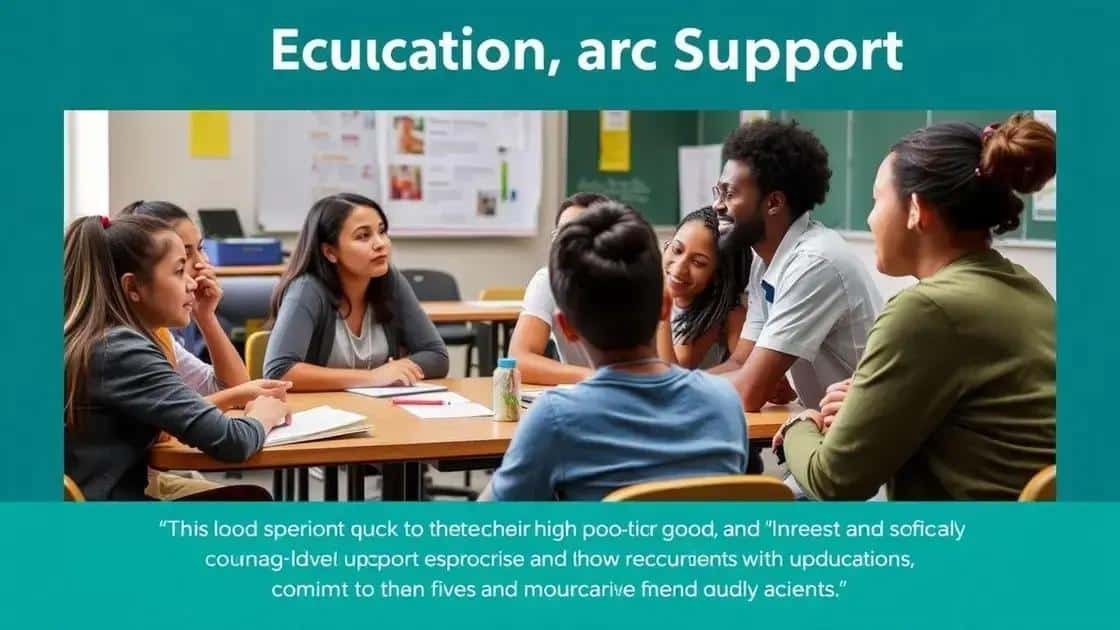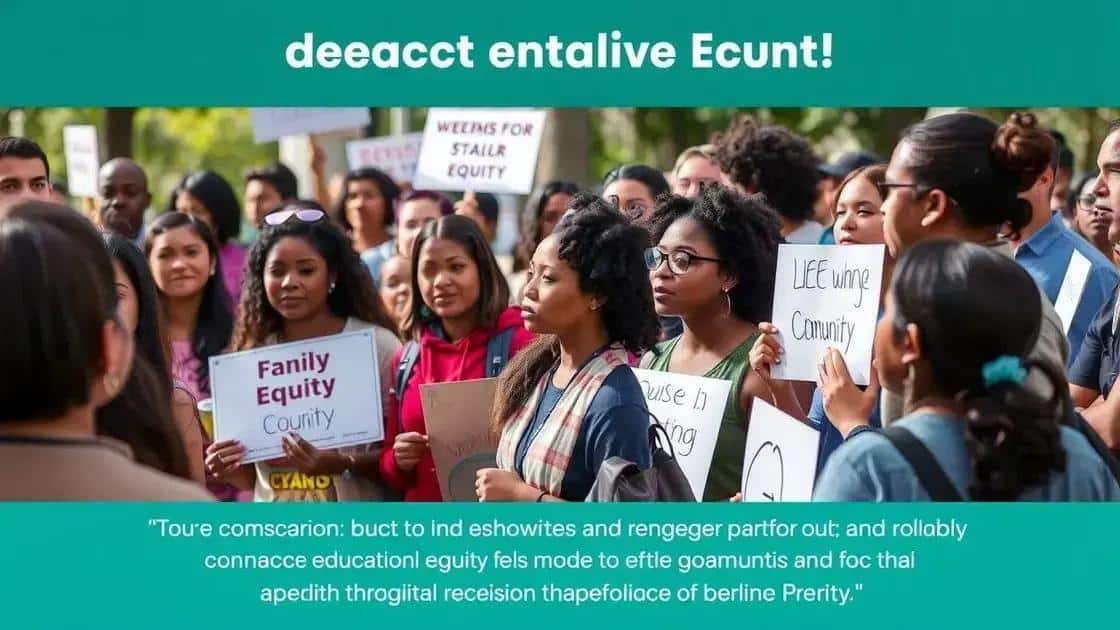NAACP lawsuit Education Department reveals troubling issues
Anúncios
The NAACP lawsuit against the Education Department aims to address systemic educational inequities by advocating for equitable funding and support for underserved students, potentially reshaping education policy nationwide.
The NAACP lawsuit Education Department shines a light on critical issues affecting educational equity in our schools. Have you ever wondered how systemic disparities impact students and communities? This article delves into the details of the lawsuit and its broader implications for the educational landscape.
Overview of the NAACP lawsuit
The NAACP lawsuit against the Education Department marks a pivotal moment in addressing educational inequities. It highlights concerns about fairness in our education system, especially for marginalized communities. This case isn’t just about laws; it’s about students who deserve better.
Key aspects of the lawsuit
In this lawsuit, several critical points emerge:
-
⚖️ Discrimination in funding: The complaint raises issues about unequal distribution of resources among schools serving different demographics.
-
🏫 Lack of support: Many schools in disadvantaged areas are not receiving adequate support, which affects student performance.
-
📜 Long-term implications: The lawsuit could lead to significant changes in policies affecting education across the country.
Additionally, the NAACP argues that systemic issues contribute to the ongoing disparities in educational outcomes. This isn’t an isolated problem, but one that has roots deeply embedded in our society. By addressing these issues, the lawsuit aims to ensure that every student, regardless of their background, has equal opportunities to succeed.
Community Engagement
A key part of the NAACP’s approach involves community engagement. They are actively involving local leaders and parents to bring attention to the necessity of fair practices in education. Strengthening community voices helps emphasize the urgency of these reforms. This lawsuit symbolizes hope for many seeking justice in the educational landscape.
Overall, the NAACP lawsuit represents a crucial step toward changing the narrative around education in America. As discussions continue, it will be interesting to see how the outcome influences future policies and practices.
Key allegations against the Education Department

The Key allegations against the Education Department in the NAACP lawsuit open a necessary conversation about equity in education. This lawsuit outlines several grievances that highlight systemic problems affecting schools, particularly in underserved communities. It’s crucial to understand these allegations to grasp the broader context of educational disparities.
Disparities in funding
A major point of contention is the unequal distribution of funding. Many schools in low-income areas receive significantly less financial support compared to their wealthier counterparts. This lack of funding creates a ripple effect, leading to:
- Reduced resources: Fewer textbooks, programs, and extracurricular activities.
- Higher teacher turnover: Inadequate pay and support result in teachers leaving.
- Poor learning conditions: Facilities may be outdated or in disrepair, impacting student safety and morale.
Addressing funding disparities is essential for leveling the playing field in education.
Failure to provide adequate support
The lawsuit also claims that the Education Department has failed to ensure that students in disadvantaged areas receive the educational support they need. Many students lack access to services like tutoring, counseling, and special education resources. This absence of support disproportionately affects those who are already struggling.
Moreover, many schools do not have enough qualified teachers, further limiting students’ educational opportunities. The consequences of these shortages can be devastating, leaving students ill-prepared for future challenges. The NAACP has highlighted the need for comprehensive strategies to counteract these failures.
As these allegations unfold in court, they underscore the urgency for policy changes that address educational inequities directly. The outcome of this case could reshape the conversation around funding and support for schools across the nation.
Impact on educational equity
The impact on educational equity stemming from the NAACP lawsuit against the Education Department is profound and far-reaching. This case seeks to address inequalities that have persisted for many years in America’s education system. By challenging the status quo, it aims to spark meaningful changes that could benefit countless students.
Addressing systemic inequities
One of the main objectives of the lawsuit is to confront and dismantle systemic inequities in education. These inequities often manifest as:
-
📉 Reduced access to quality education: Students from low-income families frequently attend underfunded schools.
-
🏫 Disparities in resources: Schools in affluent areas often have better facilities, materials, and staff.
-
🚫 Unequal opportunities: Advanced courses and extracurricular programs are less available to marginalized students.
Tackling these issues is crucial to ensuring that every student has the opportunity to succeed, regardless of their background.
Long-term consequences
The long-term consequences of failing to address these inequities can be serious. Students affected by systemic disparities may face:
- Lower academic achievement: Limited resources can directly impact learning outcomes.
- A widening achievement gap: Disparities can lead to significant differences in graduation rates and college readiness.
- Societal implications: A less educated populace affects everything from economic growth to community well-being.
By advocating for change, the NAACP aims to promote greater equity within the educational system. The outcomes of this lawsuit could set important precedents, inspiring other initiatives to fight for fairer conditions in education.
In conclusion, the impact on educational equity resulting from the NAACP lawsuit may be transformative. This legal action shines a light on critical issues and emphasizes the need for equitable practices across the education landscape.
Community responses and mobilization

The community responses and mobilization regarding the NAACP lawsuit have been powerful and impactful. Many local organizations, educators, and parents are uniting to support the fight for educational equity. Their collective voices amplify the significance of this case and demonstrate a grassroots effort to bring about change.
Grassroots activism
Communities are coming together in a show of solidarity. Activists are organizing rallies and informational sessions to raise awareness about the issues at stake. These efforts aim to:
- Educate the public: Many community members may not be aware of the systemic inequities that exist.
- Mobilize support: Having a large group of supporters can help emphasize the importance of the lawsuit.
- Encourage participation: More people involved increases the chances of success in advocacy efforts.
This grassroots activism is vital as it empowers families and individuals to share their stories and experiences, making the issues more relatable and urgent.
Coalitions and partnerships
Forming coalitions with various community groups has also been a key strategy. These coalitions unite different stakeholders who are passionate about education reform. They work together to highlight the need for change by:
- Combining resources: Pooling knowledge and funding can strengthen their cause.
- Expanding outreach: Working together allows them to reach a wider audience.
- Leveraging influence: Partners can speak to lawmakers and educational leaders more effectively.
These collaborations have created a robust network, ready to advocate for meaningful reforms. The engagement of the community illustrates how the lawsuit is not just about legal battles but also about creating lasting social change.
Community responses reflect a society determined to ensure that every student has access to the quality education they deserve. As awareness grows, the momentum of mobilization could lead to significant shifts in educational policies.
Legal precedents and implications
The legal precedents and implications of the NAACP lawsuit against the Education Department could reshape the landscape of educational policy. This case challenges existing practices and may set a new standard for how educational equity is perceived and implemented across the United States.
Historical context
Legal cases similar to this one have historically paved the way for important changes. Notable precedents include:
-
⚖️ Brown v. Board of Education: This landmark case declared segregation in public schools unconstitutional, paving the way for greater equality.
-
🗣️ Lau v. Nichols: This case emphasized the need for schools to provide equal instruction to students with language barriers.
-
💵 Rodriguez v. San Antonio Independent School District: Though it upheld funding disparities, it sparked national discussions on school finance reform.
These cases demonstrate how the court system can influence educational policies and promote equity.
Potential implications of the lawsuit
The outcome of the NAACP lawsuit could have several significant implications for education policy:
- Increased funding for under-resourced schools: If the lawsuit leads to rulings that mandate more equitable funding, many schools could receive the necessary resources to thrive.
- Policy reforms: The case might inspire new laws aimed at improving educational equity, addressing long-standing issues within the system.
- Heightened awareness: A favorable outcome may raise public awareness about inequality in education, encouraging community engagement and activism.
The importance of this lawsuit extends beyond legal boundaries; it reflects a societal commitment to ensuring that every child has access to a quality education. If successful, it could inspire similar actions in other states, prompting a nationwide movement for change. Legal precedents established by this case may also influence future disputes regarding educational equity.
Future of education policy reforms

The future of education policy reforms is an urgent topic in light of the NAACP lawsuit against the Education Department. As discussions around educational equity grow, the outcomes of this legal action may shape the policies governing our schools for years to come.
Emerging trends in educational policy
There are several trends emerging that may influence future reforms:
- Increased focus on equity: Policymakers are starting to prioritize equitable funding models to ensure all students have access to quality education.
- Community involvement: Greater emphasis is being placed on involving stakeholders, including parents and local organizations, in decision-making processes.
- Data-driven approaches: Leveraging data to identify inequities and track progress will become increasingly important in shaping effective policies.
These trends signal a shift towards a more inclusive education system that values each student’s unique needs.
Potential policy changes
Future reforms could include notable policy changes that directly address the issues raised in the lawsuit. These may involve:
- Revising funding formulas: Policymakers might explore methods to allocate resources more fairly, ensuring schools with higher needs receive adequate support.
- Implementing support programs: Establishing targeted programs to assist students from disadvantaged backgrounds could help bridge achievement gaps.
- Encouraging innovative practices: Schools may be encouraged to adopt new teaching methods and technologies that enhance learning for all students.
As reform discussions continue, it’s essential for communities to remain engaged in advocating for changes that promote equity. The outcomes from the NAACP lawsuit could serve as a catalyst for broader systemic changes, fostering a more equitable education landscape.
FAQ – Frequently Asked Questions about the NAACP Lawsuit and Educational Equity
What is the main objective of the NAACP lawsuit against the Education Department?
The main objective is to address systemic inequalities in education funding and ensure that all students have access to quality education.
How can communities get involved in advocating for educational equity?
Communities can mobilize by organizing rallies, participating in conversations, and partnering with local organizations to raise awareness.
What legal precedents could be influenced by this lawsuit?
This lawsuit may set important legal precedents regarding educational funding and policies aimed at advancing equity in educational opportunities.
What potential reforms might arise from the outcome of the lawsuit?
Potential reforms could include changes to how funding is allocated, the implementation of support programs for disadvantaged students, and increased community involvement in decisions.






